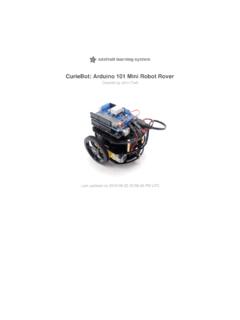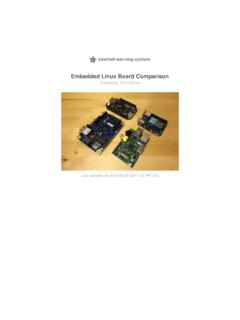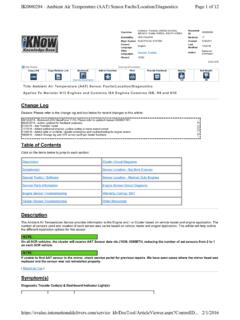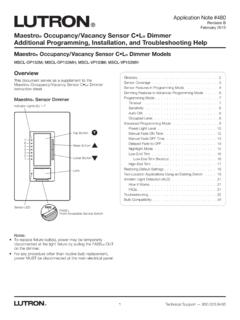Transcription of IR Sensor - Adafruit Industries
1 IR Sensor Created by lady ada Last updated on 2021-11-16 11:25:59 AM EST. Adafruit Industries Page 1 of 40. Table of Contents Overview 3. Some Stats 4. What You Can Measure 5. Testing an IR Sensor 5. IR Remote Signals 8. Using an IR Sensor 11. Making an Intervalometer 15. Reading IR Commands 19. CircuitPython 32. Hardware & Setup 33. Usage 33. Python Docs 40. Adafruit Industries Page 2 of 40. Overview IR detectors are little microchips with a photocell that are tuned to listen to infrared light. They are almost always used for remote control detection - every TV and DVD. player has one of these in the front to listen for the IR signal from the clicker.
2 Inside the remote control is a matching IR LED, which emits IR pulses to tell the TV to turn on, off or change channels. IR light is not visible to the human eye, which means it takes a little more work to test a setup. There are a few difference between these and say a CdS Photocells ( aHA): IR detectors are specially filtered for Infrared light, they are not good at detecting visible light. On the other hand, photocells are good at detecting yellow/green visible light, not good at IR light IR detectors have a demodulator inside that looks for modulated IR at 38 KHz. Just shining an IR LED wont be detected, it has to be PWM blinking at 38 KHz.
3 Photocells do not have any sort of demodulator and can detect any frequency (including DC) within the response speed of the photocell (which is about 1 KHz). IR detectors are digital out - either they detect 38 KHz IR signal and output low (0V) or they do not detect any and output high (5V). Photocells act like resistors, the resistance changes depending on how much light they are exposed to Adafruit Industries Page 3 of 40. In this tutorial we will show how to Test your IR Sensor to make sure its working Read raw IR codes into a microcontroller Create a camera intervalometer Listen for 'commands' from a remote control on your microcontroller Some Stats These stats are for the IR detector in the Adafruit shop ( ) also known as PNA4602.
4 Nearly all photocells will have slightly different specifications, although they all pretty much work the same. If there's a datasheet, you'll want to refer to it Size: square, 7mm by 8mm detector area Output: 0V (low) on detection of 38 KHz carrier, 5V (high) otherwise Sensitivity range: 800nm to 1100nm with peak response at 940nm. Frequency range is 35 KHz to 41 KHz with peak detection at 38 KHz Power supply: 3-5V DC 3mA. PNA4602 Datasheet ( ) (now discontinued) or GP1UX311QS (h ) or TSOP38238 ( ) (pin-compatible replacements). Adafruit Industries Page 4 of 40. What You Can Measure As you can see from these datasheet graphs, the peak frequency detection is at 38.
5 KHz and the peak LED color is 940 nm. You can use from about 35 KHz to 41 KHz but the sensitivity will drop off so that it wont detect as well from afar. Likewise, you can use 850 to 1100 nm LEDs but they wont work as well as 900 to 1000nm so make sure to get matching LEDs! Check the datasheet for your IR LED to verify the wavelength. Try to get a 940nm - remember that 940nm is not visible light (its Infra Red)! Testing an IR Sensor Because there is a semiconductor/chip inside the Sensor , it must be powered with 3 - 5V to function. Contrast this to photocells and FSRs where they act like resistors and thus can be simply tested with a multimeter.
6 Adafruit Industries Page 5 of 40. Here we will connect the detector as such: Pin 1 is the output so we wire this to a visible LED and resistor Pin 2 is ground Pin 3 is VCC, connect to 3-5V. When the detector sees IR signal, it will pull the output low, turning on the LED - since the LED is red its much easier for us to see than IR! Adafruit Industries Page 6 of 40. We will use 4xAA batteries (I use NiMH) so that the voltage powering the Sensor is about 4V. 2 batteries (3V) may be too little. 3 Batteries should be fine if you have a triple-AA. holder You can also get 5V from a microcontroller like an Arduino if you have one around.
7 Ground goes to the middle pin. The positive (longer) head of the Red LED connects to the +6V pin and the negative (shorter lead) connects through a 200 to 1000 ohm resistor to the first pin on the IR. Sensor . Now grab any remote control like for a TV, DVD, computer, etc. and point it at the detector while pressing some buttons, you should see the LED blink a couple times whenever the remote is pressed. Adafruit Industries Page 7 of 40. IR Remote Signals Now we know that the Sensor works, we want to figure out whats being sent right? But before we do that let's first examine exactly how data is being sent from the IR.
8 Remote (in your hand) to the IR receiving Sensor (on the breadboard). For this example we will use the Sony power on/off IR code from a Sony TV remote. Its very simple and commonly documented! Lets pretend we have a Sony remote, and we can look at exactly what light is being blasted out of the IR LED. We'll hookup a basic light Sensor (like a basic photocell!). and listen in. We won't use a decoder like a PNA4602 (just yet) because we want to see the undecoded signal. What we see is the following: Basically we see pulses or IR signal. the yellow 'blocks' are when the IR LED is transmitting and when there is only a line, the IR LED is off.
9 (Note that the voltage being at 3 VDC is just because of the way I hooked up the Sensor , if I had swapped the pullup for a pulldown it would be at ground.). The first 'block' is about long (see the cursors and the measurement on the side). If you zoom into one of those blocks . Adafruit Industries Page 8 of 40. You see that they're not really 'blocks' but actually very fast pulses! If you zoom in all the way . You can measure the frequency of the IR pulses. As you can tell by the cursors and the measurements on the side, the frequency is about OK so now we can understand how IR codes are sent. The IR transmitter LED is quickly pulsed (PWM - pulse width modulated) at a high frequency of 38 KHz and then that PWM is likewise pulsed on and off much slower, at times that are about 1-3 ms long.
10 Adafruit Industries Page 9 of 40. Why not have the LED just on and off? Why have PWM 'carrier' pulsing? Many reasons! One reason is that this lets the LED cool off. IR LEDs can take up to 1 Amp (1000. milliamps!) of current. Most LEDs only take 20mA or so. This means IR LEDs are designed for high-power blasting BUT they can only take it for a few microseconds. By PWM'ing it, you let the LED cool off half the time Another reason is that the TV will only listen to certain frequencies of PWM. So a Sony remote at 37 KHz wont be able to work with a JVC DVD player that only wants say 50 KHz. Finally, the most important reason is that by pulsing a carrier wave, you reduce the affects of ambient lighting.
















